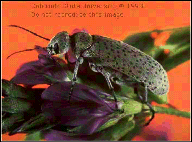 Beetle World
Beetle World 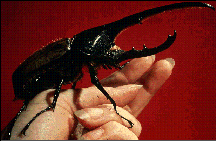
 Beetle World
Beetle World 
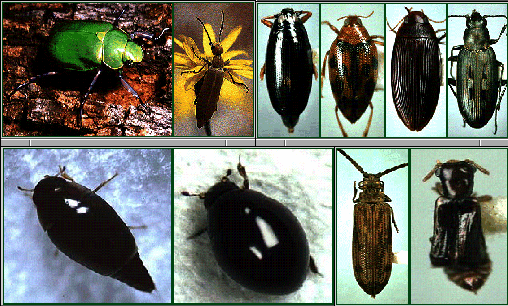
Few insects are better fitted for survival than the beetles. Nearly all of them are covered from head to foot with a strong, tough armor plate. They are powerful fliers, strong jumpers and climbers, and swift runners. Some excel in digging and boring, some in swimming and diving.
Beetles live in practically all parts of the world. They are found in the water, in the ground, and on the surface of the earth. Some are very useful to man as scavengers and as parasites on other insects. Most beetles, however, do enormous damage. They feed on every kind of plant and on every part of the plant, from root to fruit and seed. They eat stored foods, woods, fabrics, furs, books, and countless other things, including even museum specimens and beetle collections.
Some beetles have brilliant colors, often metallic or iridescent. Fireflies and glowworms are beetles that burn with the cold fire of luminescence. Some beetles are the giants of the insect world, and some are notable for their fearsome-looking horns and mandibles. Their combinations of the beautiful and curious make them favorite subjects for amateur insect collectors and especially for university collections such as the Missouri University collection and the Ohio State University collection
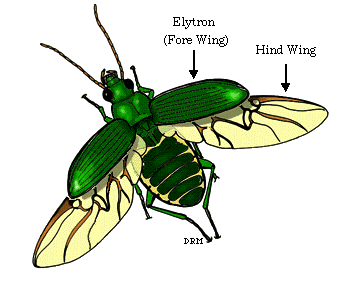
Beetles have four wings. The front pairs are greatly thickened, har, shiny wing covers called elytra (singular elytron). They are not used for flying. When a beetle flies it lifts its elytra and holds them out of the way of the filmy, membranous flying wings. When the beetle is at rest, the wing covers fold together in a straight line along the middle of the back to serve as a protective armor. The beetle can burrow, creep into narrow cracks and crevices, and withstand hard knocks without injuring the delicate flight wings.
The English name of beetles comes from the Anglo-Saxon word bitan, meaning "to bite." Most beetles are great biters with mouthparts formed for chewing. Beetles cannot suck plant juices or sip nectar.
Development:
Insects are a very diverse group and the order Coleoptera is most diverse species compared to all animals(quote from the wise). There four living suborders of beetles dated earliest from the Permian and early Triassic periods. Adults differ in the structure of the prothorax, hind wing, abdomen, ovary, and testes. The major differences are summarized in a chart
Suborder Polyphaga is by far the largest suborder, containing 85% of the known species, including rove beetles, scarabs, stag beetles, metallic wood-boring beetles, click beetles, fireflies, blister beetles, mealworms, ladybirds, leaf beetles, longhorn beetles, and weevils. Many are phytophagous. The other three suborders are Adephaga, Myxophaga, and Archostemata. The Colorado State University has a list of families in Coleoptera.
If you have any questions about the taxonomy of Coleoptera, you can
email  to the participants of the Inter-Agency Taxonomic Information System-Coleoptera Project.
to the participants of the Inter-Agency Taxonomic Information System-Coleoptera Project.
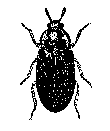 Damaged fabrics, furnishings and clothing that contain natural animal fibers are a result of carpet beetle destruction. Things that are synthetic are resistant to attack, but mixtures of synthetic and natural fibers can be damaged. The natural habitats of carpet beetles are nests of birds, rodents, insects and spiders. They then can spread into homes to damage carpets, rugs, and clothing. Usually, they can be carried into the house on cut flowers because they also feed on pollen.
Damaged fabrics, furnishings and clothing that contain natural animal fibers are a result of carpet beetle destruction. Things that are synthetic are resistant to attack, but mixtures of synthetic and natural fibers can be damaged. The natural habitats of carpet beetles are nests of birds, rodents, insects and spiders. They then can spread into homes to damage carpets, rugs, and clothing. Usually, they can be carried into the house on cut flowers because they also feed on pollen.
Dr. Jay B. Karren has a more detailed paper on carpet beetles found on gopher 
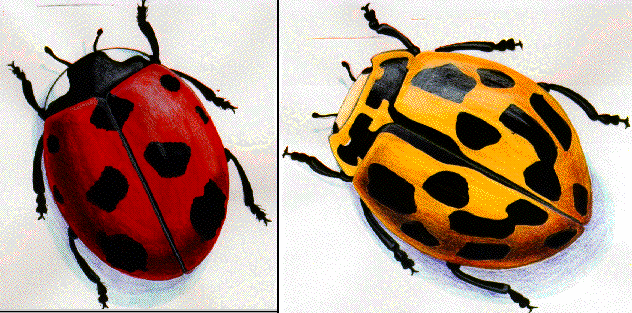
Lady beetles are boadly oval, convex insects that often are brightly colored. There are about 5,000 species worldwide and over 400 species in North America. some lady beetles are similar to the leaf beetles (Chriysomelidae) but differ by having three distinct tarsal segments instead of appearing to have four as do leaf beetles. Adults and larvae are pedaceous, commonly found feeding on aphids and sometimes scale insects, mealybugs, and mites. Two common specides in the genus Epilachna are plant feeders and garden pests. Lady beetle adults hibernate in the winter and some are found in large aggregations under debris or on boulders at high elevations. Larvae are covered with spines or tubercles and often are dark with bright bands of color.
The eggs are yellowish orange and spindleshaped. They are deposited in compact clusters on foliage or ground litter. Averages indicate that the female will lay from 50 to 300 eggs in her lifetime. The larvae of most species are blue-black and orange and are alligator-shaped. They do not have large sickle-shaped mandibles (jaws) as do the larvae of the green lacewing. The average life cycle from egg to adult is about 28 days.
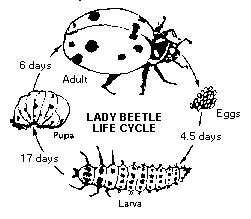
 and prices, also.
and prices, also.


Here is my bibliography  .
.

The following has been added by the Electronic Desktop Project:
 Contact Us
Contact UsIf you are an educator who is using our NEXTSTEP or virtual applications in the classroom, we would especially like to hear from you. Let us know what you are doing and how it is working out. Continued support for this project will depend on its impact in science education.
If you are an educator who is interested in making use of our NEXTSTEP or virtual applications, please let us know how we can help.
 Return to the Electronic Desktop Project home page
Return to the Electronic Desktop Project home page
![]() Check out the WWW Virtual Application Catalog from the EDP
Check out the WWW Virtual Application Catalog from the EDP
 Check out the NEXTSTEP Application Catalog from the EDP
Check out the NEXTSTEP Application Catalog from the EDP
 Visit the home page for California State University, Los Angeles
Visit the home page for California State University, Los Angeles